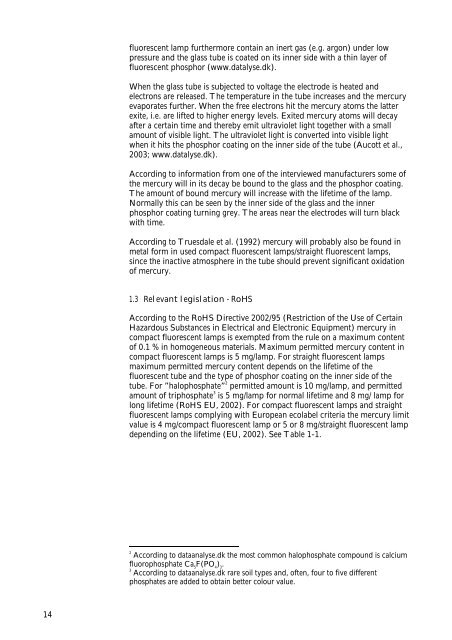No. 104 - Miljøstyrelsen
No. 104 - Miljøstyrelsen
No. 104 - Miljøstyrelsen
Create successful ePaper yourself
Turn your PDF publications into a flip-book with our unique Google optimized e-Paper software.
14<br />
fluorescent lamp furthermore contain an inert gas (e.g. argon) under low<br />
pressure and the glass tube is coated on its inner side with a thin layer of<br />
fluorescent phosphor (www.datalyse.dk).<br />
When the glass tube is subjected to voltage the electrode is heated and<br />
electrons are released. The temperature in the tube increases and the mercury<br />
evaporates further. When the free electrons hit the mercury atoms the latter<br />
exite, i.e. are lifted to higher energy levels. Exited mercury atoms will decay<br />
after a certain time and thereby emit ultraviolet light together with a small<br />
amount of visible light. The ultraviolet light is converted into visible light<br />
when it hits the phosphor coating on the inner side of the tube (Aucott et al.,<br />
2003; www.datalyse.dk).<br />
According to information from one of the interviewed manufacturers some of<br />
the mercury will in its decay be bound to the glass and the phosphor coating.<br />
The amount of bound mercury will increase with the lifetime of the lamp.<br />
<strong>No</strong>rmally this can be seen by the inner side of the glass and the inner<br />
phosphor coating turning grey. The areas near the electrodes will turn black<br />
with time.<br />
According to Truesdale et al. (1992) mercury will probably also be found in<br />
metal form in used compact fluorescent lamps/straight fluorescent lamps,<br />
since the inactive atmosphere in the tube should prevent significant oxidation<br />
of mercury.<br />
1.3 Relevant legislation - RoHS<br />
According to the RoHS Directive 2002/95 (Restriction of the Use of Certain<br />
Hazardous Substances in Electrical and Electronic Equipment) mercury in<br />
compact fluorescent lamps is exempted from the rule on a maximum content<br />
of 0.1 % in homogeneous materials. Maximum permitted mercury content in<br />
compact fluorescent lamps is 5 mg/lamp. For straight fluorescent lamps<br />
maximum permitted mercury content depends on the lifetime of the<br />
fluorescent tube and the type of phosphor coating on the inner side of the<br />
tube. For ”halophosphate” 2 permitted amount is 10 mg/lamp, and permitted<br />
amount of triphosphate 3 is 5 mg/lamp for normal lifetime and 8 mg/ lamp for<br />
long lifetime (RoHS EU, 2002). For compact fluorescent lamps and straight<br />
fluorescent lamps complying with European ecolabel criteria the mercury limit<br />
value is 4 mg/compact fluorescent lamp or 5 or 8 mg/straight fluorescent lamp<br />
depending on the lifetime (EU, 2002). See Table 1-1.<br />
2<br />
According to dataanalyse.dk the most common halophosphate compound is calcium<br />
fluorophosphate Ca F(PO ) .<br />
5 4 3<br />
3<br />
According to dataanalyse.dk rare soil types and, often, four to five different<br />
phosphates are added to obtain better colour value.

















